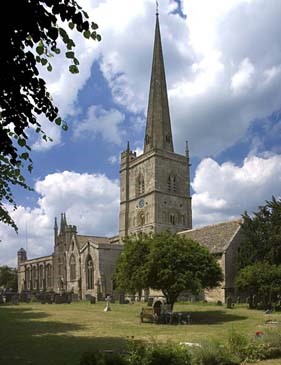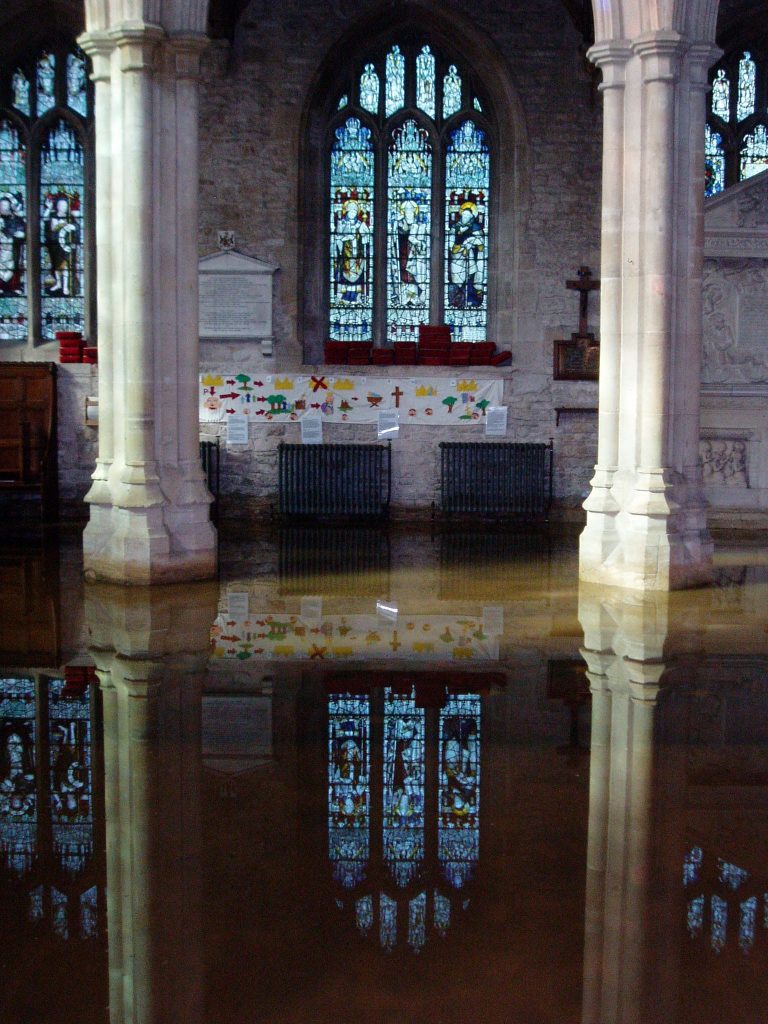
The Church
Three hundred years in the making in stone, St John the Baptist Church (Burford Church) dates to the 12th Century and has almost Cathedral like proportions, with a footprint alone of about 820m². The Church still has its original west doorway and Norman tower, now capped with a steeple from the 15th century. The Church has a fine fan-vaulted ceiling and five medieval screens dividing various chapels.
In 1870 the architect G E Street, who was about to begin a major programme of restoration in the Church, wrote at the beginning of his recommendations:
“I must begin by saying that there is, in my opinion, no church in the whole diocese of Oxford which exceeds it in beauty and architectural interest. It is not only that in scale it is grander than most parish churches, but also that in its architectural detail it is singularly rich and beautiful”.
His opinion was strikingly endorsed in 1999 when Simon Jenkins, in England’s Thousand Best Churches, gave Burford Church 5 stars – the only such award in Oxfordshire, and one of only 18 in the country. He described it as the
“queen of Oxfordshire, a paragon and museum of the English Parish Church. It is full of beautiful artefacts and fascinating stories of history.”
In the 19th Century the floor of the Church was raised ‘several inches’ because of incidents of flooding. This hazard was artificially created when the water course of the time, a mill channel, was excavated, possibly in the Middle Ages, or possibly in the 17th Century. At that time the river was some distance away, and the site would originally have been dry.
The Incident
Following torrential rainfall over a prolonged period, large swathes of the UK were flooded, including Hull, Sheffield, Rotherham and Tewkesbury. The flooding received widespread media attention, being “headline news” for several days. Tens of thousands of buildings were affected, with considerable disruption and difficulty caused to businesses and families. Insurers, Loss Adjusters and Damage Management companies were tested not only by the volume of cases suddenly requiring prompt attention, but also by the fact that the damage had occurred in so many different areas of the UK, some hundreds of miles away from the others. The total cost of the damage is currently estimated at £4 billion.
Burford Church was flooded for about 48 hours or so, to an approximate depth of 450mm (18”) throughout, following torrential localised rainfall and after the adjacent River Windrush broke its banks.
The Damage
The stone lower walls, and of course the floors, throughout the Church, were left soaking by the flood, as were many of the contents. A layer of sandy silt was deposited over the entire floor and lower walls of the building, also affecting many floor mounted contents (such as antique chairs and benches, pews, kneelers, altar cloths, tables, bookcases and cupboards) the choir stalls.
With the Church closed and usually receiving over 100,000 visitors from all over the world every year, the loss of revenue was significant.
The Restoration
On notification of the incident, the interested Insurers and Chartered Loss Adjusters brought in Continuity to work with the Diocesan Architects, Acanthus Clews, in the restoration work required. The first site meeting was held as soon as the waters had receded and, after completing risk assessments and method statements, Continuity began work within 24 hours.
A full time project manager, Gavin Smith was charged with responsibility for all aspects of the remedial works required and he worked with a number of supervisors and operatives trained and experienced in the decontamination of flooded historic buildings. At this point in time, because of the widespread flooding of several parts of the UK, Continuity had already implemented their “surge plan”: as a result, we could not have as many of our own full time staff working in the Church as we would do normally, and instead had to hire in a number of fully trained and skilled operatives from our vetted labour supply company.
After a triage exercise, undamaged but “at risk” contents items were removed to a safe, clean and dry area of the Church (St Thomas’ Chapel) which was “tented up” with polythene sheeting to keep this chapel – and the unaffected contents items now stored there – safe from the relatively high levels of humidity present in the rest of the Church. A number of fans and an air conditioning unit were brought in to make sure that that this Chapel remained at the right humidity levels.
The floors at Burford Church are all stone and many areas are covered with historic tiles. Delicate and gentle hand cleaning of the floors was carried out under the direction of Continuity project manager, who was in full time attendance and who managed the restoration project from beginning to end.
A team of up to 14 people first used vacuum cleaners and soft bristled brushes to gently remove the sandy silt deposits that had been left by the flooding throughout the Church: this minimised the risk of scratching stonework and the beautifully tiled floors. They then used weak water mixed Ph neutral detergents, developed by our chosen suppliers, to gently wash the floors and walls with soft bristle brushes. The areas were then rinsed with clean water, dried with cloths and then allowed to air dry before being gently sprayed with a specially formulated sanitising “mist” to kill any remaining bacteria. The same approach was applied to pipework and other services, using brushes as small as toothbrushes in inaccessible areas.
Fabric items were listed, removed and dry cleaned, with affected furniture items also being taken away for drying and careful restoration to their pre-incident condition.
We liaised throughout with the appointed Architects, the Vicar, Secretary, Verger, Churchwardens et al.

The Drying
It is well established that components of old buildings suffer greatly when they are dried too quickly, or when heat is used: timber elements including floors, doors, frames and panelling may warp, twist or split: salts will migrate through old stone and plasterwork, causing them to blister, powder and exfoliate. Many painted surfaces will peel and flake. Unless carried out properly, the remedial work can become much more damaging than the flood itself. Over-drying is another serious danger.
Historic buildings such as Burford Church need to be dried gently and slowly and that is exactly what Continuity did: natural ventilation was maximised and a system of large fans was established throughout the Church, with relative humidity measurement readings being taken regularly. The fans were set up so that they drew dry air into the building, at the same time blowing wet air out.
As is commonly the case, the choir stalls had been built on oak plinths with substantial voids beneath them. These needed to be opened up to allow air circulation around and beneath them and to enable the team to clean and sanitise the affected areas – and to minimise the risk of mould growth or a future rot outbreak. Some boards were carefully removed to facilitate this. They were numbered to ease identification on replacement and then high velocity air movers were utilised to accelerate the drying of the timberwork and stone floors.
No dehumidification equipment was utilised at all to dry the building, nor was any heat.
Nonetheless, on 4th September – exactly 6 weeks after our initial visit to the Church – it was announced by independent experts to be dry, enabling a large wedding, planned for 8th September, to go ahead. The Church had been re-opened to the public 3 weeks after we were involved, keeping the loss of revenue to the minimum level possible.